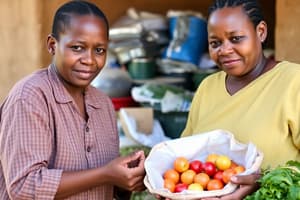Podcast
Questions and Answers
Which ministry manages the Public Distribution System (PDS) in India?
Which ministry manages the Public Distribution System (PDS) in India?
- Ministry of Rural Development
- Ministry of Food Processing Industries
- Ministry of Agriculture
- Ministry of Consumer Affairs, Food and Public Distribution (correct)
What does the Targeted Public Distribution System (TPDS) in India target?
What does the Targeted Public Distribution System (TPDS) in India target?
- The poor and vulnerable sections of the population (correct)
- Agricultural policies in India
- Large-scale food grain production
- Nutritional programs for children
What is the main objective of the Public Distribution System (PDS) in India?
What is the main objective of the Public Distribution System (PDS) in India?
- To manage agricultural policies in India
- To provide food grains to all sections of the population
- To ensure food security for the poor and vulnerable sections of the population (correct)
- To implement nutritional programs in India
What is the primary concern addressed by food security programs in India?
What is the primary concern addressed by food security programs in India?
Which government entity operates under the Ministry of Consumer Affairs, Food and Public Distribution in India?
Which government entity operates under the Ministry of Consumer Affairs, Food and Public Distribution in India?
What is the overarching goal of food subsidy programs in India?
What is the overarching goal of food subsidy programs in India?
What is the primary goal of the National Food Security Act (NFSA) in India?
What is the primary goal of the National Food Security Act (NFSA) in India?
What is the main goal of the Integrated Child Development Services (ICDS) in India?
What is the main goal of the Integrated Child Development Services (ICDS) in India?
What contributes to food insecurity in India?
What contributes to food insecurity in India?
What is the primary goal of the Mid-day Meal Scheme (MDMS) in India?
What is the primary goal of the Mid-day Meal Scheme (MDMS) in India?
What is the primary objective of the National Agricultural Policy (NAP) in India?
What is the primary objective of the National Agricultural Policy (NAP) in India?
How does poverty contribute to food insecurity in India?
How does poverty contribute to food insecurity in India?
What is the world's largest food security guarantee program?
What is the world's largest food security guarantee program?
What is the overarching goal of nutritional programs in India?
What is the overarching goal of nutritional programs in India?
How does urbanization contribute to food insecurity in India?
How does urbanization contribute to food insecurity in India?
What is the main objective of the Public Distribution System (PDS) in India?
What is the main objective of the Public Distribution System (PDS) in India?
What contributes to unpredictable weather patterns affecting crop yields in India?
What contributes to unpredictable weather patterns affecting crop yields in India?
Flashcards are hidden until you start studying
Study Notes
Food Security in India
Food security is a significant concern in India, where a large population faces issues with access to safe and nutritious food. The country has implemented various programs and policies to address food security and ensure the well-being of its citizens. This article discusses the Public Distribution System (PDS), Food Subsidy Programs, Nutritional Programs, Food Insecurity Causes, and Agricultural Policies in India.
Public Distribution System (PDS)
The Public Distribution System (PDS) is a central government scheme that aims to provide food grains to the poor and vulnerable sections of the population. It is managed by the Ministry of Consumer Affairs, Food and Public Distribution. PDS operates under the Ministry of Consumer Affairs, Food and Public Distribution in India. The PDS is designed to provide food grains to the poor and vulnerable sections of the population, with the objective of ensuring food security for all.
Food Subsidy Programs
India has implemented several food subsidy programs to ensure food security for its citizens. These programs include:
-
Targeted Public Distribution System (TPDS): TPDS is an improved version of the PDS, targeting the poor and vulnerable sections of the population. It aims to provide food grains to those in need, reducing food insecurity and malnutrition.
-
National Food Security Act (NFSA): The NFSA aims to provide food security to more than 80% of the population by providing a legal entitlement of 5 kg of food grains per person per month at highly subsidized prices. It is the world's largest food security guarantee program.
Nutritional Programs
India has implemented various nutritional programs to address malnutrition and improve the health of its citizens. These programs include:
-
Integrated Child Development Services (ICDS): ICDS is a comprehensive community-based program designed to improve the nutritional and health status of children below six years of age and pregnant and lactating mothers.
-
Mid-day Meal Scheme (MDMS): MDMS is a school-based meal program that provides a cooked meal to children in primary schools. It aims to improve the nutritional status of children and attract them to schools.
Food Insecurity Causes
Several factors contribute to food insecurity in India, including:
-
Poverty: A significant portion of the population lives below the poverty line, making it difficult for them to afford enough food to meet their daily nutritional requirements.
-
Climate change: Climate change has led to unpredictable weather patterns, affecting crop yields and food production.
-
Rapid urbanization: Urbanization has led to the loss of agricultural land and the displacement of farmers, leading to food insecurity.
Agricultural Policies
India has implemented various agricultural policies to improve food security and support farmers. These policies include:
-
National Agricultural Policy (NAP): NAP aims to improve the productivity of agriculture, increase farmers' income, and promote sustainable agriculture.
-
National Food Security Act (NFSA): NFSA provides legal entitlements for food grains at highly subsidized prices, ensuring food security for a significant portion of the population.
In conclusion, food security in India is a complex issue that requires a multifaceted approach. The government has implemented various programs and policies to address food insecurity, including PDS, food subsidy programs, nutritional programs, and agricultural policies. While these efforts have made a significant impact, there is still work to be done to ensure food security for all citizens.
Studying That Suits You
Use AI to generate personalized quizzes and flashcards to suit your learning preferences.




